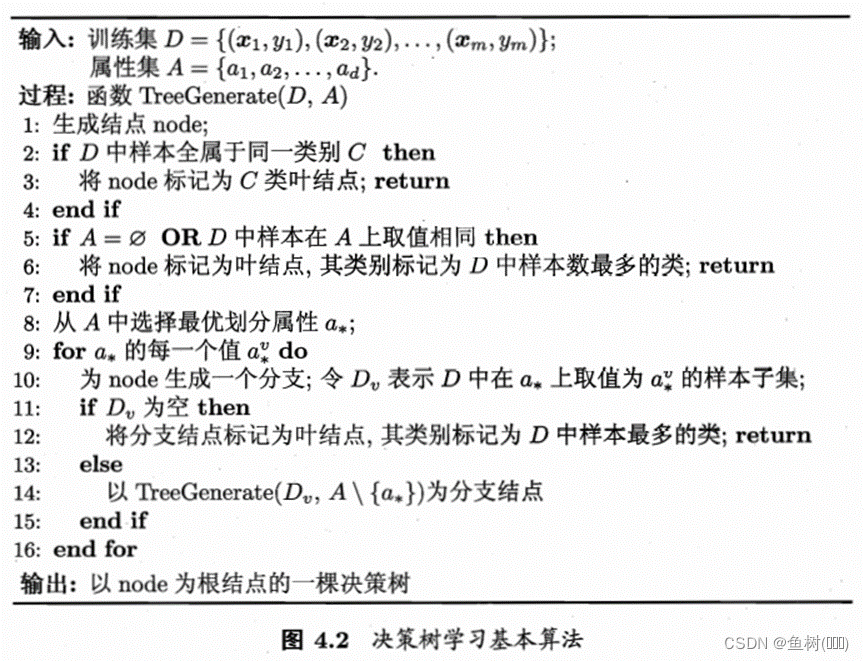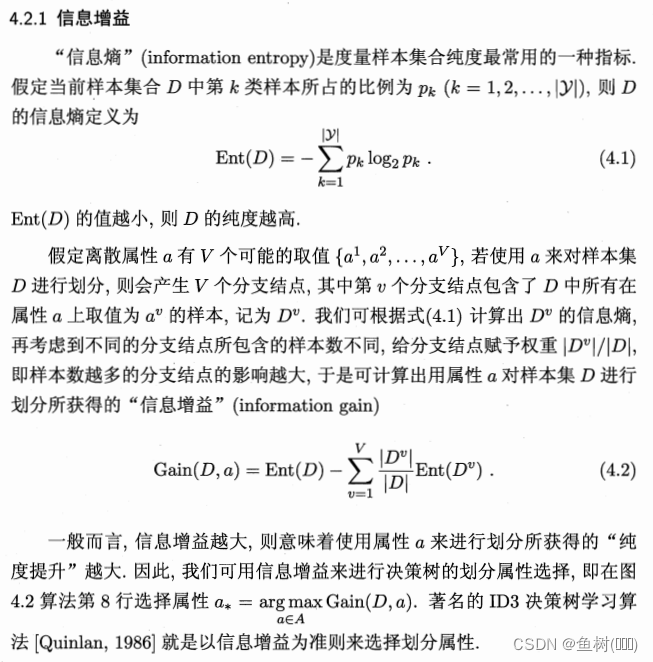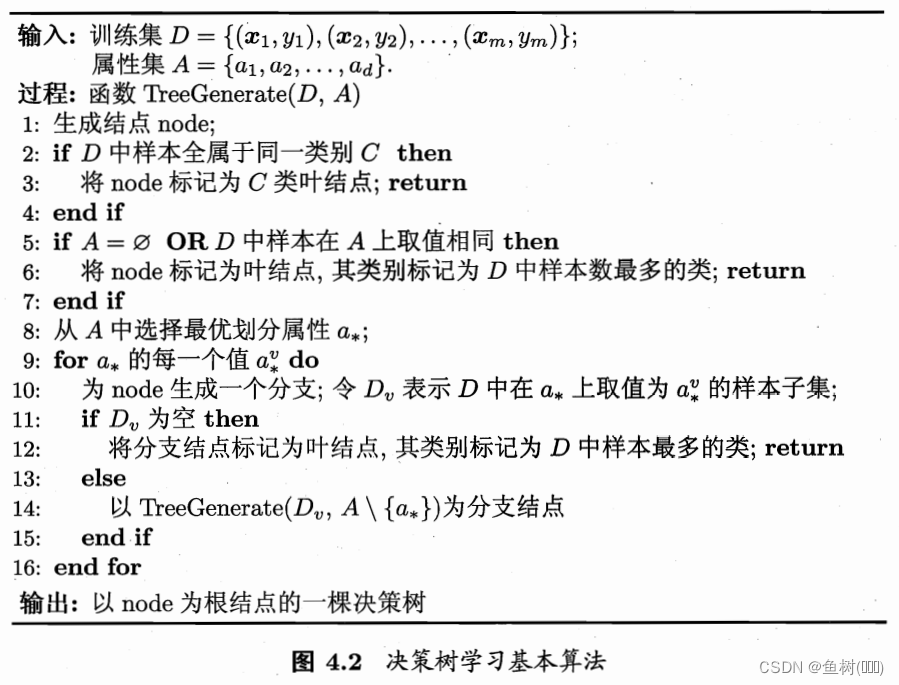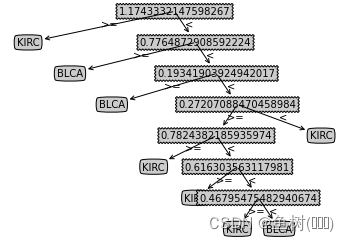前言
文章内容为对数据挖掘实验作业的记录,如果您是为了作业而来看的这篇文章,还请不要无脑拷贝,本人编程能力较弱,代码写的并不优雅,注释尽可能写的详细了。
决策树算法
决策树是一类常见的机器学习方法.以二分类任务为例,我们希望从给定训练数据集学得一个模型用以对新示例进行分类,这个把样本分类的任务,可看作对“当前样本属于正类吗?”这个问题的“决策”或“判定 ”过程。
一般的,一棵决策树包含一个根结点、若干个内部结点和若干个叶结点,叶结点对应于决策结果,其他每个结点则对应于一个属性测试;每个结点包含的样本集合根据属性测试的结果被划分到子结点中;根结点包含样本全集。从根结点到每个叶结点的路径对应了一个判定测试序列。决策树学习的目的是为了产生一棵泛化能力强,即处理未见示例能力强的决策树,其基本流程遵循简单且直观的“分而治之"策略。

根据决策树的算法思想,如何选择最优划分属性至关重要,随着划分过程的不断进行,我们希望决策树的分支结点所包含的样本尽可能属于同一类别。
根据不同的划分规则,目前常见的决策树算法有ID3算法和C4.5算法
ID3算法
ID3算法主要根据信息增益对属性的重要程度进行划分


以上介绍出自著名机器学习书籍——西瓜书,这里只介绍了针对离散值的处理方式,但实际上,我们的样本数据更多的是连续性的数值,当遇到这种数据时,需要选择恰当的划分策略对数据进行划分,再应用ID3算法。
决策树算法进行分类的具体步骤
根据以上对决策树算法以及ID3、C4.5算法的分析,我们可以大致得到使用决策树对数据进行分类的具体步骤
(1) 数据预处理
(2) 对数据进行划分,计算各个属性的信息增益(ID3)或信息增益率(C4.5)
(3) 选择较大的信息增益或信息增益率对应的划分点构建决策树
(4) 使用样本数据对构建的决策树进行测试,得到正确率最大的决策树对应的深度
(5) 对陌生的数据进行分类预测
导入库
import numpy as np
import pandas as pd
from math import log
import matplotlib.pyplot as plt
分析样本数据
# 从本地读取样本数据集,这里选择前两种癌症数据进行分析
BLCA = pd.read_csv(r'数据集/BLCA/rna.csv')
KIRC = pd.read_csv(r'数据集/KIRC/rna.csv')
print(BLCA.shape)
print(KIRC.shape)
(3217, 400)
(3217, 489)
# 对数据进行转置,之后每行对应一个样本数据,每列对应一个属性
BLCASet = BLCA.T
BLCASet = BLCASet.iloc[1:,:].astype('float32')
KIRCSet = KIRC.T
KIRCSet = KIRCSet.iloc[1:,:].astype('float32')
# 插入一列数据用来标识不同的类别
BLCASet.insert(loc=3217, column=3217, value='BLCA')
KIRCSet.insert(loc=3217, column=3217, value='KIRC')
# 转为numpy类型方便处理
BLCASet = np.array(BLCASet)
KIRCSet = np.array(KIRCSet)
# 将两种癌症样本数据进行合并
DataSet = np.vstack((BLCASet,KIRCSet))
# 看一下合并后的样本数据规模
print(DataSet.shape)
(887, 3218)
# 对于连续的样本值,这里采取的划分方案是使用属性的最大最小值的平均值作为划分点
'''
至于为什么这种划分也会有效?
因为只要采取了某种划分策略对数据进行了划分,这个行为必然会带来一定的信息增益
"划分"所带来的信息增益就会给分类提供有用的信息
'''
maxlist = np.max(DataSet,axis=0)
minlist = np.min(DataSet,axis=0)
midlist = (maxlist[:-1]+minlist[:-1])/2
print(midlist)
[-0.3077172040939331 0.5645202994346619 0.038697242736816406 ...
0.08328396081924438 0.25938647985458374 0.39306795597076416]
计算各个属性对应的信息增益
def I(s1, s2):
'''
计算信息熵
'''
t = s1+s2
p1 = float(s1/t)
p2 = float(s2/t)
if p1*p2!=0:
return -p1*log(p1,2)-p2*log(p2,2)
else:
if p1==0:
return -p2*log(p2,2)
else:
return -p1*log(p1,2)
# 计算总熵
I_t = I(BLCASet.shape[0],KIRCSet.shape[0])
# 接下来为计算每种属性下的信息增益
row = DataSet.shape[0] # 获取样本行数
col = DataSet.shape[1] # 获取样本列数
Gain = [] # 存储样本属性的信息增益值
Sel = [] # 存储哪种分支可以确定类别,0表示>=,1表示<
Dec = [] # 存储可以确定的分支为哪一类,这里取值为"BLCA""KIRC"两种
S11 = []
S12 = []
S21 = []
S22 = []
for i in range(col-1): # 对样本每个属性求其信息增益
data = DataSet[:,i] # 这一列的数据
div = midlist[i] # 这一列的划分点
s11 = 0
s12 = 0
s21 = 0
s22 = 0
for j in range(row): # 对数据进行统计
if data[j]>=div:
if DataSet[j][-1] == 'BLCA':
s11 = s11+1 # 大于等于划分点且属于BLCA的
if DataSet[j][-1] == 'KIRC':
s12 = s12+1 # 大于等于划分点且属于KIRC的
else:
if DataSet[j][-1] == 'BLCA':
s21 = s21+1 # 小于划分点且属于BLCA的
if DataSet[j][-1] == 'KIRC':
s22 = s22+1 # 小于划分点且属于KIRC的
I1 = I(s11, s12) # 计算熵I(s11,s12)
I2 = I(s21, s22) # 计算熵I(s21,s22)
S11.append(s11)
S12.append(s12)
S21.append(s21)
S22.append(s22)
Gain.append(I_t-((s11+s12)/len(data)*I1+(s21+s22)/len(data)*I2)) # 计算信息增益
if I1<I2:
Sel.append(0)
if s11>s12:
Dec.append('BLCA') # 表示如果一个数据大于等于划分点,将其判断为BLCA
else:
Dec.append('KIRC') # 表示如果一个数据大于等于划分点,将其判断为KIRC
else:
Sel.append(1)
if s21>s22:
Dec.append('BLCA') # 表示如果一个数据小于划分点,将其判断为BLCA
else:
Dec.append('KIRC') # 表示如果一个数据小于划分点,将其判断为KIRC
构建决策树
# 按照Gain中值的降序,对其下标进行排序
indexList = np.argsort(Gain)[::-1]
# 这里选择数据,利用数据与划分点的大小关系对其进行分类
def decisionTree(data, i):
if i==len(data)-1:
# print(f"到第{i}层可以做决策")
if Sel[indexList[i-1]]==0:
if S11[indexList[i-1]]>=S12[indexList[i-1]]:
return 'KIRC'
else:
return 'BLCA'
else:
if S21[indexList[i-1]]>=S22[indexList[i-1]]:
return 'KIRC'
else:
return 'BLCA'
elif Sel[indexList[i]]==0 and data[i]>=midlist[indexList[i]]: # 大于等于可以决策
# print(f"到第{i}层可以做决策")
return Dec[indexList[i]]
elif Sel[indexList[i]]==1 and data[i]<midlist[indexList[i]]: # 小于可以决策
# print(f"到第{i}层可以做决策")
return Dec[indexList[i]]
else:
return decisionTree(data, i+1)
计算决策树的正确率
# deep指定决策树的深度
deep = 6
data = np.array(DataSet[:,indexList[:deep]])
data = np.hstack((data,DataSet[:,-1].reshape(data.shape[0],1)))
total = data.shape[0]
corr = 0
mis = 0
for i in range(0, total):
global corr, mis
res = decisionTree(data[i], 0)
# print(res)
if res == data[i][-1]:
# print('正确')
corr = corr + 1
else:
# print('错误')
mis = mis + 1
print(f"{corr}/{total}")
print(f"深度为{deep}的决策树的正确率为{corr/total}")
879/887
深度为6的决策树的正确率为0.9909808342728298
决策树的可视化
# 接下来为绘图的代码,唯独这里不是这一块不是原创,不过好像网上用的好像都一样?
def getNumLeafs(myTree):
numLeafs = 0
firstStr = list(myTree.keys())[0]
secondDict = myTree[firstStr]
for key in secondDict.keys():
if type(secondDict[key]).__name__=='dict':
numLeafs += getNumLeafs(secondDict[key])
else:
numLeafs += 1
return numLeafs
def getTreeDepth(myTree):
maxDepth = 0
firstStr = list(myTree.keys())[0]
secondDict = myTree[firstStr]
for key in secondDict.keys():
if type(secondDict[key]).__name__ == 'dict':
thisDepth = 1 + getTreeDepth(secondDict[key])
else:
thisDepth = 1
if thisDepth > maxDepth : maxDepth = thisDepth
return maxDepth
decisionNode = dict(boxstyle = "sawtooth",fc="0.8")
leafNode = dict(boxstyle = "round4",fc="0.8")
arrow_args = dict(arrowstyle="<-")
def plotNode(nodeTxt,centerPt,parentPt,nodeType):
createPlot.ax1.annotate(nodeTxt,xy=parentPt,\
xycoords='axes fraction',xytext=centerPt,textcoords='axes fraction',\
va="center",ha="center",bbox=nodeType,arrowprops=arrow_args)
def plotMidText(cntrPt,parentPt,txtString):
xMid = (parentPt[0]-cntrPt[0])/2.0 + cntrPt[0]
yMid = (parentPt[1]-cntrPt[1])/2.0 + cntrPt[1]
createPlot.ax1.text(xMid,yMid,txtString)
def plotTree(myTree,parentPt,nodeTxt):
numLeafs = getNumLeafs(myTree)
depth = getTreeDepth(myTree)
firstStr = list(myTree.keys())[0]
cntrPt = (plotTree.xoff + (1.0 + float(numLeafs))/2.0/plotTree.totalW,\
plotTree.yoff)
plotMidText(cntrPt,parentPt,nodeTxt)
plotNode(firstStr,cntrPt,parentPt,decisionNode)
secondDict = myTree[firstStr]
plotTree.yoff = plotTree.yoff - 1.0/plotTree.totalD
for key in secondDict.keys():
if type(secondDict[key]).__name__=='dict':
plotTree(secondDict[key],cntrPt,str(key))
else:
plotTree.xoff = plotTree.xoff + 1.0 / plotTree.totalW
plotNode(secondDict[key],(plotTree.xoff,plotTree.yoff),\
cntrPt,leafNode)
plotMidText((plotTree.xoff,plotTree.yoff),cntrPt,str(key))
plotTree.yoff = plotTree.yoff + 1.0 / plotTree.totalD
def createPlot(inTree):
fig = plt.figure(1,facecolor='white')
fig.clf()
axprops = dict(xticks=[],yticks=[])
createPlot.ax1 = plt.subplot(111,frameon=False,**axprops)
plotTree.totalW = float(getNumLeafs(inTree))
plotTree.totalD = float(getTreeDepth(inTree))
plotTree.xoff = -0.5/plotTree.totalW
plotTree.yoff = 1.0
plotTree(inTree,(0.5,1.0),'')
plt.show()
# 分析绘制树的代码可以知道,我们首先需要提供用“字典”表示的树
# 编写一个递归构建树的函数
def genInTree(deep,i):
if i==deep:
if Sel[indexList[i]]==0:
if S11[indexList[i-1]]>=S12[indexList[i-1]]:
return {midlist[indexList[i]]:{">=":"BLCA","<":"KIRC"}}
else:
return {midlist[indexList[i]]:{">=":"KIRC","<":"BLCA"}}
else:
if S21[indexList[i-1]]>=S22[indexList[i-1]]:
return {midlist[indexList[i]]:{">=":"KIRC","<":"BLCA"}}
else:
return {midlist[indexList[i]]:{">=":"BLCA","<":"KIRC"}}
else:
if Sel[indexList[i]]==0:
return {midlist[indexList[i]]:{">=":Dec[i],"<":genInTree(deep,i+1)}}
else:
return {midlist[indexList[i]]:{">=":genInTree(deep,i+1),"<":Dec[i]}}
# 其中deep为深度,也可以手动填
createPlot(genInTree(deep,0))

写在最后
这学期真是挺忙的 >_<,可以说算是百忙之中抽出时间来写这个选修课作业了ಥ_ಥ






















 980
980











 被折叠的 条评论
为什么被折叠?
被折叠的 条评论
为什么被折叠?










